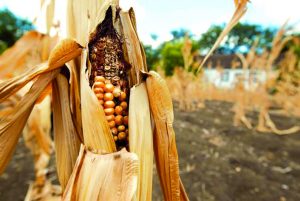
Famines have been known to cause widespread starvation, and now with crops and food being traded globally, one hiccup in the growth of just one crop could cause a massive global catastrophe of apocalyptic proportions.
In the past, a poor year for crops, whether it was too wet or too dry, rarely impacted those outside the immediate region. Only those in close proximity to the failed crops would have to contend with the rising prices and shortages. But with the food is now being shipped around the globe, one failure could be apocalyptic, and experts are trying to warn us. Weather and the cyclic nature of the earth, combined with government regulations and war, could make producing viable crops in quantities that will feed humanity difficult in the next several years, especially when considering the increasing human population.
Less than one-quarter of Earth’s total cropland produces nearly three-quarters of the staple crops that feed the world’s population. These staples include corn, wheat, and rice, and are the most important cereal crops. The areas which grow these crops are our planet’s major breadbaskets. But experts warn that simultaneous crop failures could impact our very near future making global famine a reality. When compounded with the effects of war and the ever-increasing government regulations on agriculture across the globe, food production will continue to face even more difficulty in the coming years.
Pardee Center postdoctoral scholar John Patrick Connors and Anthony Janetos with the Conversation and Director of the Frederick S. Pardee Center for the Study of the Longer-Range Future and Professor of Earth and Environment, have been using some mathematical models to study the potential environmental and economic impacts of failures in multiple breadbaskets around the world. They limit their study to only “climate change” however, placing no blame on government beasts who actually bloody their own hands when they hamper food production. But these experts do want the government to “help” should this tragedy occur.
The Pardee Center has published a research agenda that discusses what we still need to know about these risks. Key questions include understanding the full distribution of risks, whether increased international trade can ameliorate risk and where the most responsive and the most sensitive regions are. Ultimately, understanding and preparing for multiple breadbasket failures will require input from climate scientists, agronomists, ecologists, remote sensing experts, economists, political scientists, and decision-makers. –DailyMail UK
The good news, according to Janetos, is that not all regions respond in the same way to shocks in other places in the world. Some could bring new land into production quickly, easing stresses caused by crop failures elsewhere. But in order to make global food systems more robust, we need to know more about the most damaging consequences of multiple breadbasket failures, because in the past, when the world’s breadbaskets suffered shortages, the cost of food increased greatly.
For example, regional droughts and heat waves in the Ukraine and Russia in 2007 and then again in 2010 damaged wheat crops and caused global wheat prices to spike by substantial amounts in both years. In 2012, heat and drought in the United States slashed national corn, soybean, and other crop yields by up to 27 percent.
But this is all fairly minor compared what a global catastrophe of failed crops could look like. The combined effects of government and war with the natural cycles of Earth could quickly cause a famine. Many experts assert that world food production will have to double by 2050 to feed the earth’s growing population and satisfy rising demand for meat, poultry, and dairy products in developing countries. But the environmentalists seek to strike a balance between the destruction of forests and food production. So experts actually suggest using crops such as Monsanto’s DroughtGuard hybrid corn to prevent crops from failing when there is a lack of water.
Unfortunately, with earth’s population increasing exponentially, there may be no other way to feed the masses than with genetically modified food.
Leaving out the impact of government on food production lessens the blow somewhat. But it’s important to remember that often the hands of those who produce our food are often tied thanks to laws and regulations. Getting around this won’t be easy either. Perhaps it’s time to focus on growing your own food in preparation for the unthinkable.






0 Comments